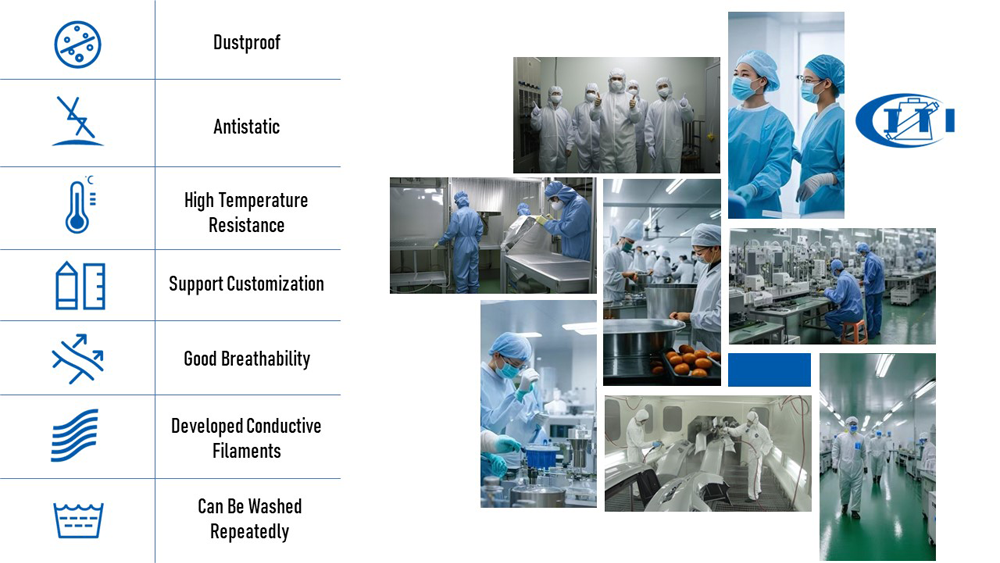
The Essential Role of Antistatic Clothing in Pharmaceutical Manufacturing
2025-09-24 17:35
In the highly controlled environments of pharmaceutical manufacturing, where the margin for error is virtually zero, a seemingly minor spark of static electricity can have catastrophic consequences. The industry's reliance on sensitive electronic equipment, volatile solvents, and sterile processes makes the control of electrostatic discharge (ESD) not just a matter of operational efficiency, but of product quality and personnel safety. This article explores the science behind ESD risks, the function of antistatic workwear, and the evolving standards that are shaping the future of cleanroom safety.
Understanding the Invisible Threat – Electrostatic Discharge in Pharma
Electrostatic charge is generated when two materials contact and then separate, a common occurrence with routine movement in a facility. In a pharmaceutical context, this simple phenomenon poses a multi-faceted threat:
Product Contamination: This is the primary concern. Static charges attract airborne particulate matter—dust, skin cells, fibers—like a magnet. In areas where potent active pharmaceutical ingredients (APIs) are handled, uncontrolled ESD can cause cross-contamination between different drug batches, compromising their purity and potency. A charged garment can draw contaminants from the environment or even shed more particles itself, directly threatening the sterility of the production line.
Damage to Sensitive Equipment: Modern pharmaceutical manufacturing and quality control labs are filled with highly sensitive electronic equipment, such as analytical scales, chromatography systems, and microprocessor-controlled machinery. An electrostatic discharge, even one too small for a human to feel, can damage or alter the calibration of these devices, leading to costly repairs, production downtime, and inaccurate test results.
Fire and Explosion Hazards: While often associated with industries like petrochemicals, the risk exists in pharma where flammable solvents (e.g., alcohol, acetone) are used in processes like coating, extraction, and cleaning. A spark from an electrostatic discharge can serve as an ignition source, potentially triggering a fire or explosion.
Worker Discomfort and Inefficiency: The constant nuisance of static shocks, or the feeling of clothing clinging to the body, can cause discomfort and distraction for operators, potentially leading to errors in meticulous manual tasks.
The Science of Protection: How Antistatic Fabric Works
Antistatic clothing is engineered to mitigate these risks through two primary mechanisms: charge dissipation and charge prevention.
Dissipative Fabrics: These materials are not conductors like metal, but they possess sufficient electrical conductivity to allow any static charge that builds up on the body to flow safely and gradually to the ground. This is typically achieved by weaving conductive threads—often composed of carbon-infused fibers or stainless steel filaments—into the fabric. These threads create a network that safely channels the charge away.
Low-Charging Fabrics: Some synthetic fabrics are inherently prone to generating high levels of static charge. Advanced antistatic fabric is designed with hydrophilic (water-attracting) properties or special fiber treatments that reduce the triboelectric effect (the generation of charge through friction). By minimizing the initial generation of charge, the risk is controlled at its source.
For pharmaceutical applications, this antistatic fabric must also meet stringent requirements for cleanroom compatibility, meaning it should be low-linting, durable to withstand repeated industrial laundering, and comfortable for extended wear.
Integration into the Cleanroom Ecosystem
Antistatic garments are not standalone solutions; they are integral parts of a comprehensive ESD control program within a cleanroom. This program includes:
ESD-Protected Areas (EPAs): Designated zones where static-sensitive processes occur.
Proper Grounding: Wrist straps, footwear, and flooring systems are used in conjunction with antistatic clothing to ensure a continuous path for static electricity to flow to the ground.
Strict Gowning Procedures: The process of donning antistatic coveralls, boots, and hoods is a critical step performed in airlocked gowning rooms to prevent contamination from entering the cleanroom.
The performance of these garments is governed by international standards, such as the IEC 61340 series, which specify requirements for surface resistance and charge decay time to ensure effectiveness.

The Green Imperative: Sustainability in Antistatic Workwear
As the pharmaceutical industry increasingly prioritizes sustainability, the demand for eco-friendly protective gear is growing. The environmental impact of antistatic clothing is now a key consideration. This involves:
Durable Design: Garments constructed for long lifecycles reduce waste.
Sustainable Materials: The use of recycled polymers in synthetic fibers and environmentally conscious production methods.
REACH Compliance: Ensuring that chemicals used in fabric treatments are safe and comply with regulations like the EU's REACH (Registration, Evaluation, Authorisation, and Restriction of Chemicals).
Spotlight on CJTI – Your Partner in Safe and Sustainable Antistatic Solutions
As a specialized manufacturer of protective workwear, CJTI understands the critical role that reliable antistatic clothing plays in the pharmaceutical industry. CJTI is committed to producing high-quality antistatic fabric and garments that meet the highest standards of performance and environmental responsibility.
CJTI's antistatic workwear is engineered for excellence in the most demanding environments. Our fabrics are designed to provide consistent and reliable static control, ensuring product integrity and operator safety. We focus on creating garments that are not only functional—offering durability, comfort, and compliance with industry standards—but are also produced with a commitment to green manufacturing principles. This includes exploring sustainable material choices and processes to minimize the environmental footprint of our products.
By choosing CJTI, pharmaceutical companies gain a partner dedicated to providing effective, dependable, and responsibly manufactured antistatic clothing solutions that help safeguard both their products and their people.












